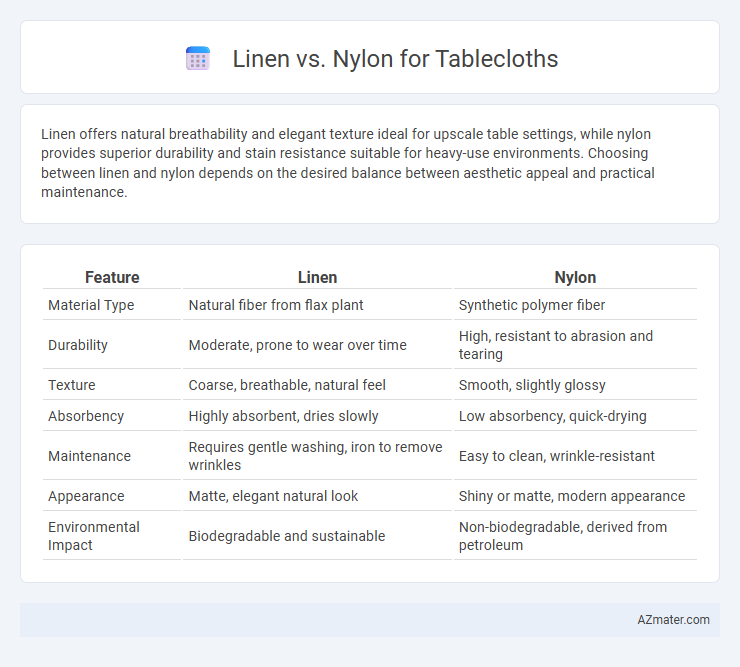Linen offers natural breathability and elegant texture ideal for upscale table settings, while nylon provides superior durability and stain resistance suitable for heavy-use environments. Choosing between linen and nylon depends on the desired balance between aesthetic appeal and practical maintenance.
Table of Comparison
| Feature | Linen | Nylon |
|---|---|---|
| Material Type | Natural fiber from flax plant | Synthetic polymer fiber |
| Durability | Moderate, prone to wear over time | High, resistant to abrasion and tearing |
| Texture | Coarse, breathable, natural feel | Smooth, slightly glossy |
| Absorbency | Highly absorbent, dries slowly | Low absorbency, quick-drying |
| Maintenance | Requires gentle washing, iron to remove wrinkles | Easy to clean, wrinkle-resistant |
| Appearance | Matte, elegant natural look | Shiny or matte, modern appearance |
| Environmental Impact | Biodegradable and sustainable | Non-biodegradable, derived from petroleum |
Introduction to Tablecloth Materials
Linen and nylon are popular materials for tablecloths, each offering distinct advantages based on durability and texture. Linen provides a natural, breathable fabric with a crisp look that enhances formal and casual dining settings, while nylon offers exceptional stain resistance and easy maintenance, ideal for high-traffic or outdoor use. Understanding the fiber properties and care requirements of linen versus nylon helps in selecting the perfect tablecloth material tailored to specific dining needs and aesthetic preferences.
Overview of Linen and Nylon Fabrics
Linen, derived from flax fibers, is a natural fabric known for its breathability, durability, and elegant texture, making it ideal for sophisticated tablecloths that resist wrinkles and absorb moisture. Nylon, a synthetic polymer fabric, offers exceptional strength, elasticity, and resistance to abrasion and stains, providing a practical and easy-to-clean option for table coverings. The choice between linen and nylon tablecloths depends on the desired aesthetic and functional benefits, with linen excelling in natural luxury and nylon in resilience and maintenance.
Aesthetic Appeal: Texture and Appearance
Linen tablecloths offer a natural, textured appearance with a subtle matte finish that exudes elegance and rustic charm, making them ideal for classic or organic-themed settings. Nylon tablecloths provide a smooth, shiny surface that reflects light, giving a modern and sleek look suited for contemporary or formal environments. The unique texture of linen allows for visible weave patterns and a soft, breathable feel, while nylon's synthetic fiber construction results in a uniform texture with enhanced durability and stain resistance.
Durability and Longevity Comparison
Linen tablecloths exhibit exceptional durability due to their strong natural fibers, which become softer and more resilient with each wash, making them ideal for long-term use. Nylon tablecloths, while resistant to wrinkles and stains, are prone to wear and tear over time, especially under frequent washing and heavy use. Overall, linen outperforms nylon in longevity, maintaining its structural integrity and aesthetic appeal for years when properly cared for.
Stain Resistance and Maintenance
Linen tablecloths, made from natural fibers, offer moderate stain resistance but require careful maintenance, including gentle washing and frequent ironing to maintain their texture and appearance. Nylon tablecloths provide superior stain resistance due to their synthetic composition, allowing for easy spot cleaning and low-maintenance care, typically machine washable and quick to dry. Choosing between linen and nylon for tablecloths depends on the balance between natural fiber appeal and practical stain-resistant functionality.
Comfort and Feel on the Table
Linen tablecloths offer a soft, breathable texture that enhances comfort with a natural, slightly textured feel, ideal for a warm and inviting dining experience. Nylon tablecloths provide a smooth, durable surface that resists wrinkles and stains but may feel less breathable and more synthetic to the touch. Choosing linen ensures a cozy, organic ambiance while nylon emphasizes practicality with a sleek, easy-care finish.
Environmental Impact and Sustainability
Linen tablecloths offer superior environmental benefits due to their natural fibers derived from flax plants, which require minimal water and pesticides during cultivation. In contrast, nylon tablecloths are made from synthetic polymers produced through energy-intensive processes involving petrochemicals, contributing to higher carbon emissions and non-biodegradable waste. Choosing linen supports sustainable agriculture and reduces microplastic pollution, making it a more eco-friendly option for table linens.
Cost and Value for Money
Linen tablecloths typically cost more due to their natural fibers and premium texture, offering durability and a luxurious aesthetic that ages well with washing. Nylon tablecloths are more affordable, providing water resistance and easy maintenance, making them a practical choice for frequent use or casual settings. When evaluating cost versus value for money, linen excels in longevity and elegance, while nylon delivers budget-friendly durability and convenience.
Best Uses: Formal vs. Casual Settings
Linen tablecloths are ideal for formal settings due to their natural texture, elegant appearance, and breathability, making them perfect for weddings, dinner parties, and upscale events. Nylon tablecloths suit casual settings as they offer durability, stain resistance, and easy cleaning, fitting well for everyday meals, picnics, and outdoor gatherings. Choosing linen enhances sophistication and ambiance, while nylon prioritizes practicality and low maintenance.
Final Verdict: Choosing the Right Tablecloth Material
Linen tablecloths offer natural breathability, elegant texture, and durability ideal for formal dining, while nylon provides stain resistance, easy maintenance, and affordability perfect for casual or high-traffic settings. Choosing between linen and nylon depends on balancing aesthetic preferences with practical needs such as cleaning frequency and event type. For a sophisticated, eco-friendly option, linen is preferred; for budget-friendly, low-maintenance use, nylon is the optimal choice.

Infographic: Linen vs Nylon for Tablecloth
 azmater.com
azmater.com